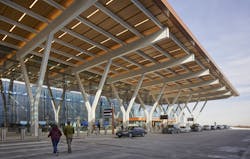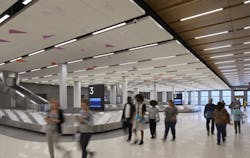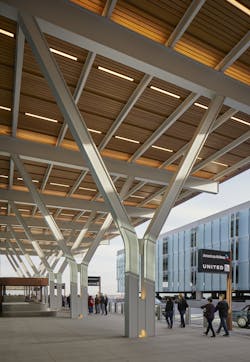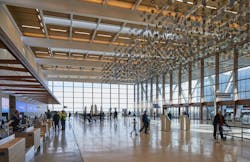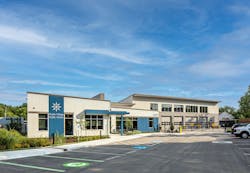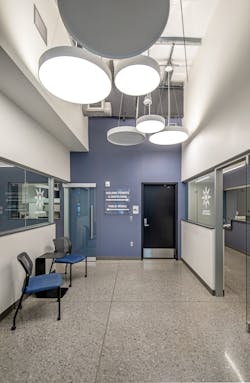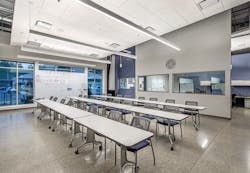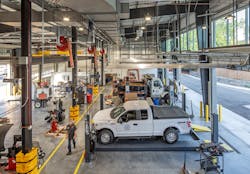Kansas City, where the Midwest gives way to the Great Plains, is a hub for efficiency and design innovation. Two of the region’s latest architectural projects — an expansive international airport terminal and a suburban public works facility — recently earned high sustainability ratings, with the help of solid-state lighting. Energy efficiency drew the projects' designers to specify LEDs over conventional light sources.
A glowing global gateway
Project Credits
- Project: Kansas City International Airport
- Architect: Skidmore, Owings & Merrill
- Lighting designer: LightWorks, Inc.
Designed by global architecture firm Skidmore, Owings & Merill, the newest terminal of Kansas City International Airport, in Missouri, recently achieved LEED v4 Gold BD+C certification. The 1.1 million-square foot facility is the first airport terminal in the Midwest and the second terminal in the U.S. to achieve this high rating.
Completed in February 2023, the project earned a significant part of its efficiency through LED lighting. The terminal deploys about 50 lighting solutions, totaling more than 14,000 fixtures.
Specifying LEDs contributed directly to the project’s ability to earn LEED points related to energy performance, said Kathi Vandel, owner of LightWorks, the project’s engineer of record. Based in Weston, Mo., the firm was commissioned for lighting design and engineering for the terminal, as well as a parking garage.
Layered, streamlined lighting choices reflect the project’s linear nature and reinforce architectural themes of the I-shaped facility, Vandel said. The luminaire most commonly appearing is H.E. Williams MX4S linear downlight; the 6-foot-long frosted luminaire sets into the ceiling trough and is finished to match the striking hemlock. “Additional layers included clerestory uplights, beam uplights, and wall washing,” she said. “All of these elements in the front-of-house public spaces utilized a 3000K color temperature to provide warmth to the materials while creating a welcoming ambience for the patrons.”
LightWorks also collaborated on a custom fixture to create a continuous, inside-to-outside lighting element to meet architectural design specifications. “We did have to work with the manufacturers to achieve the IP rating the project required on the exterior fixtures in a way that they seemingly looked like the same luminaire [inside],” Vandel said. The modified outdoor MX4S fixtures are IP65 rated; have gasketed diffusers and end caps and liquid-tight cord entries; and can withstand temperatures down to 40°C. Their mounting and conduit routing were also modified for installation.
A network of lighting controls by Crestron enables 0–10V dimming for most luminaires inside the terminal. “The lighting control system provided dimming and switching control for the public and back-of-house areas,” Vandel said. “The entire facility utilized a combination of network and distributed control systems requiring a complex sequence of operations, plan layouts, schedules, and riser diagrams.” As construction wrapped, the team finalized dimming levels for the various zones.
Automatic controls, as well as daylight harvesting in specific zones, are utilized as required by the International Energy Conservation Code. “The daylight zone varies in size based on the parameters and the amount of glazing in the space,” Vandel said. For example, the terminal concourses have a 15-foot-wide perimeter band as a daylight zone.
As a final point of pride, the project team successfully obtained a LEED innovation credit for its complete use of SSL technology, because LEDs are free of mercury.
Good, well-lit neighbors
Project Credits
- Project: Public Works, City of Prairie Village, Kan.
- Architect & lighting designer: Clark & Enersen
Just 27 miles south of the Kansas City International Airport, the town of Prairie Village, Kan., achieved LEED Platinum certification for its 20,000-square-foot public works facility, completed in 2022. Years prior, the city had conducted a feasibility study for its municipal structures to ascertain a maintenance strategy.
When assessors evaluated the city’s public works facilities, they found mixed results. “We had some good structures, we had some OK structures, and we had some structures that were not worth buying a 5-gallon bucket of paint for,” said city engineer Melissa Prenger. The city council thought starting fresh made more sense and approved the construction of a new facility on-site. But the approval came with a caveat: The design had to aim for LEED Platinum.
Prenger knew this was a lofty goal. “LEDs were always a part of the conversation,” she said. “We decided early on that.” Their energy efficiency, array of possible color temperatures, dimming ability, and programmability were all desirable features, particularly because the public works facility is situated in a residential area.
From a lighting power density standpoint, LED lighting was also practically a prerequisite to meet ASHRAE 90.1, according to Brent Adams, electrical engineer and principal board member at Clark & Enerson, the project’s architect and lighting designer.
All 36 lighting solutions specified for the facility are LED, he said. Interior fixtures include modern, minimalist luminaires and circular pendants. In the crew conference room, long, rectilinear pendants — the Slot 2 by Mark Architectural Lighting — provide diffuse illumination over the length of the seating area. Small, cylindrical fixtures — the High Center Beam Pendant Stem Cylinder from Gotham Lighting’s Incito line — provide direct light in other areas.
The mechanic shop used for maintaining the city fleet, including its snowplows, allowed the facility to utilize several industrial fixtures. Its high ceiling features JEBL LED High Bay pendant fixtures from Lithonia Lighting, with black die-cast aluminum housings.
Per a LEED requirement for interior lighting quality, at least 70% of the fixtures needed a color-rendering index at or above 80, Adams said, but all project fixtures met this bar. “That’s an easy one to beat with good, high-quality LED fixtures nowadays.” He said that achievement was less a reason for the team to brag, but more a “testament to the industry” and the significant advances of LEDs in the past decade. That LEED credit also requires a rated life of 24,000 hours; another easy check box for LEDs.
The city had stringent exterior lighting requirements to avoid light trespass: zero horizontal foot-candles at the property line and tight restrictions on the vertical plane. Adams believes those specifications would have been impossible to meet were it not for modern LED fixtures.
Keeping light out of the adjacent residential properties meant the fixtures needed sharp cutoffs and targeted directionality, while maintaining a uniform amount of light. This also helped the project achieve the LEED credit for light pollution reduction, which it met via BUG ratings, as well as the design team’s own light footprint calculations. “We reduced the amount of lighting in the parking lot … so that we could be good neighbors,” Prenger said.
To illuminate the facility’s outdoor flagpole at night, the team avoided spotlights, which typically point up, contributing to light pollution. Instead, they found a pole-top fixture that illuminates down 360 degrees, the American StarGazer by Concord American Flagpole. This was another first for the team, Adams said. "It doesn't matter which way the wind is blowing; that flag will be illuminated."
The dimmability and controllability of LEDs also helped the design meet its energy mandate. The interior lighting systems is controlled on the Acuity nLight platform, which Adams said uses low-voltage power via Category 5e cable that connects switches, dimmers, vacancy and occupancy sensors, and photocells to a power pack relay. Exterior lighting is controlled via timeclock and photocell. Adams added that when the fixtures' integral sensors detect an occupant, the lighting "dims up" from 50% lumen output to full brightness. "With LED fixtures … — as opposed to some other older technologies — when you dim them, it’s a pretty direct linear relationship to your energy savings,” Adams said. That is, dimming the lights by 50% will reduce energy use essentially by 50%. Lights in the facility are also on occupancy sensors.
Comfort is also integral to sustainability, which is one aspect Prenger appreciates about LEED. She suffers from migraines and keeps the lights dim or off in her office. The new control system remembers her custom office settings.
“There are [LEED] points that are directly tied to creature comforts,” she said, referring to the environment she can create through controlling and dimming the light. “Studies have shown that people who are more comfortable are also more productive.”
Ultimately, the new public works facility earned an impressive 83 LEED points, sliding past the required 80 points required for Platinum certification.
SHEL EVERGREEN (shelevergreen.com) is a science journalist and multimedia professional based in Colorado. She’s produced work for MIT Technology Review, Ars Technica, Canary Media, and more. In her spare time, she volunteers as a mentor to young writers and hangs out in the mountains with her partner and pets.
Follow our LinkedIn page for our latest news updates, contributed articles, and commentary, and our Facebook page for events announcements and more. You can also find us on Twitter.

Shel Evergreen
SHEL EVERGREEN (shelevergreen.com) is a science journalist and multimedia professional based in Colorado. She’s produced work for MIT Technology Review, Ars Technica, Canary Media, and more. In her spare time, she volunteers as a mentor to young writers and hangs out in the mountains with her partner and pets.
